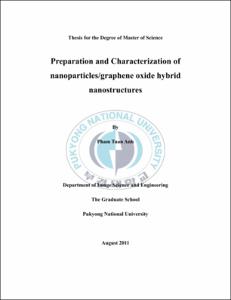Preparation and Characterization of nanoparticles/graphene oxide hybrid nanostructures
- Alternative Title
- 나노입자/산화 그래핀 혼성 나노구조의 제조 및 특성연구
- Abstract
- The combination of carbon family materials such as, one dimensional (1D) carbon nanotubes (CNTs) and two dimensional (2D) graphene nanosheets with inorganic nanoparticles has opened up a new way to produce arrays of novel hybrid nanomaterials for various potential applications. As a novel carbon nanomaterial, graphene is expected as a high-potential nanoscale building block for developing such hybrid materials because it possesses large interfacial surface area as well as the superior electrical conductivity far much better than its analogous counterpart, CNTs. Along with relatively inexpensive sources (graphite) for preparing graphene, these advantages have led to the rise of scientific investigations among researchers in employing them as a cheap substitute for CNTs. In the frame of this thesis, new concepts for the functionalization of graphene based nanomaterials with various functional nanoparticles are presented. Up to date, although there were some reports on the immobilization of inorganic nanoparticles on graphene oxide, it is recognized that there is still a major drawback that must be overcome to meet requirements for practical applications. The drawback is that nanoparticles may easily leach out from the graphene surface during applications due to the weak interactions, such as electrostatic or π-π stacking interactions between graphene oxide surface and nanoparticles. The main goal in this thesis is to develop new and simple approaches for the immobilization of functional nanoparticles on graphene oxide surface by covalent bondings. The resulting hybrid nanostructures were characterized using a wide range of analytical techniques. The results underpinned in this thesis indicate that the potential of utilizing graphene-based hybrid nanostructure as a cost effective platform for many potential applications such as nanobiotechnology, solar energy conversion, photonic devices or catalysts.
- Issued Date
- 2011
- Awarded Date
- 2011. 8
- Type
- Dissertation
- Keyword
- nanoparticles graphene functionalization
- Publisher
- pukyong National University, the department of Image Science and Engineering
- Affiliation
- 대학원 이미지시스템공학과
- Department
- 대학원 이미지시스템공학과
- Advisor
- Jeong Yeon Tae
- Table Of Contents
- Chapter 1 1
Introduction 1
1.1. Introduction to chemical functionalization of graphene oxide 1
1.2. The development and application of nanoparticles/graphene hybrid materials 2
1.3. Project description and objectives 3
1.4. Organization of this thesis 4
Bibliography 5
Chapter 2 6
Covalent functionalization of graphene oxide with polyglycerol and their use as templates for anchoring magnetic nanoparticles 6
2.1. Introduction 7
2.2. Experimental sections 9
2.2.1. Materials 9
2.2.2. Preparation of GO 9
2.2.3. Synthesis of PG-g-GO 10
2.2.4. Synthesis of boronic acid functionalized Fe@Au nanoparticles (B-f-MNPs) 10
2.2.5. Synthesis of magnetic nanoparticle-immobilized PG-g-GO (MNPs-i-PG-g-GO) 11
2.2.6. Characterization techniques 11
2.3. Results and discussion 12
2.3.1. Characterization of B-f-MNPs 12
2.3.2. Characterization of hybrid nanostructures 15
2.3.3. Morphologies of hybrid nanostructures 20
2.3.4. Dispersion stability of hybrids in distilled water 23
Conclusions 25
Bibliography 25
Chapter 3 29
Facile covalent immobilization of cadmium sulfide quantum dots on graphene oxide nanosheets: Preparation, characterization, and optical properties 29
3.1. Introduction 30
3.2. Experimental section 32
3.2.1. Materials 32
3.2.2. Synthesis of 4-aminothiophenol-functionalized CdS QDs (4-ATP-f-CdSQDs) 33
3.2.3. Synthesis of GONS 33
3.2.4. Synthesis of acyl chloride-functionalized GONS 34
3.2.5. Preparation of CdS-immobilized GONS (CdS-i- GONS) 34
3.2.6. Characterization techniques 34
3.3 Results and discussion 35
3.3.1. Characterization of the 4-ATP-f-CdSQDs 35
3.3.2. The immobilization of 4-ATP-f-CdSQDs on the GONS surface (CdS-i-GONS) 37
3.3.3. Morphologies of hybrid material 44
3.3.4. Thermal stability of hybrid material 45
3.3.5. Optical properties of hybrid material 47
Conclusion 48
Bibliography 49
Chapter 4 52
A simple approach for immobilization of gold nanoparticles on graphene oxide sheets by covalent bonding 52
4.1. Introduction 53
4.2. Experimental 55
4.2.1. Materials 55
4.2.2. Synthesis of 4-aminothiophenol – functionalized AuNPs (4-ATP-f-AuNPs) 55
4.2.3. Preparation of GOS 56
4.2.4. Immobilization of AuNPs on the surface of GOS 56
4.2.5. Characterization techniques 57
4.3. Results and discussion 57
4.3.1. Characterization of 4-ATP-f-AuNPs 57
4.3.2. Characterization of AuNPs-i-GOS hybrid material 60
4.3.3. Thermal stability of hybrid material 64
4.3.4. Morphologies of hybrid material 65
Conclusions 67
Bibliography 68
Summary and Outlook 71
List of Publications 72
- Degree
- Master
- Files in This Item:
-
-
Download
 graphene oxide hybrid nanostructures.pdf
기타 데이터 / 2.02 MB / Adobe PDF
graphene oxide hybrid nanostructures.pdf
기타 데이터 / 2.02 MB / Adobe PDF
-
Items in Repository are protected by copyright, with all rights reserved, unless otherwise indicated.